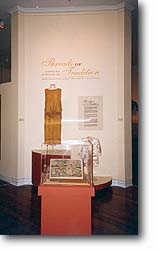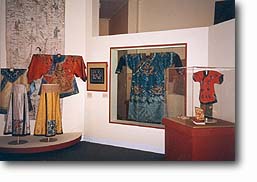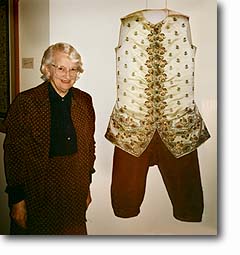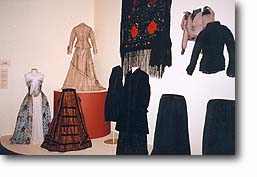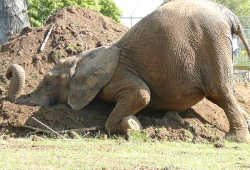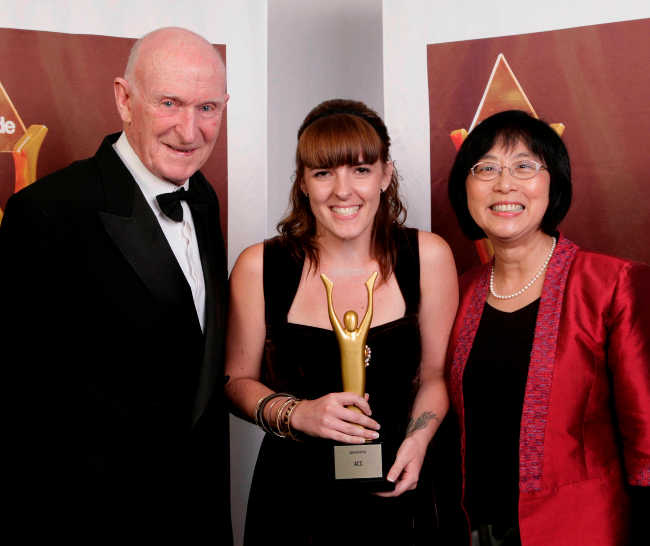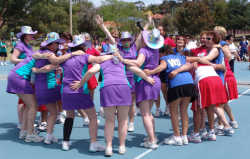An exhibition of Costumes and Textiles from the Dunedin Public Art Gallery Collections
Dorothy – 01/02/01
|
|
| Entry to the exhibition Photo source Margery Blackman |
|
|
| Collection of small bags Photo source Margery Blackman |
Dunedin Public Art Gallery 17 November 2001 – 12 May 2002 A Dunedin Public Art Gallery exhibition
Margery Blackman, Dunedin textile historian and conservator, has worked for months to curate Threads of Tradition, an exhibition of the textiles and costumes stored for years in the Dunedin Public Art Gallery.
The textile and costume collections at the Gallery have been built up over a period of seventy years, almost entirely by donations from generous supporters. British and European traditions are represented among the 144 exhibited items including eighteenth century waistcoats, nineteenth century lace, shawls and elaborately decorated bags, Victorian costume and a 1920s beaded dress.
English embroidery from seventeenth century One of the most precious and interesting items is a small but very fine embroidery from the 17th century, depicting biblical themes from the Old Testament book of Esther. King Ahasuerus of Babylon (also known as Xerxes, 486-465 BC) deeply loved his wife Esther, a beautiful Jewess. She pleaded with him to save her people when Haman who was Prime Minister wanted to exterminate them. In the centre Esther is making her plea to the king, and in the top right hand corner Haman is being hung from the gallows. There is no attempt in the embroidery to portray Jewish costumes of Esther’s day. As with many historical performances in seventeenth century theatre the characters wear the fashions of the 1660s.
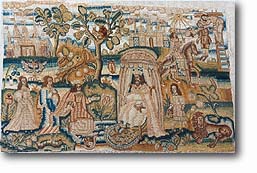 |
| English Embroidery – the story of Esther – 1660-70 Photo source Margery Blackman Click here for a larger version |
|
|
| Chinese costume and textiles Photo source Margery Blackman |
Many upper class women spent a lot of time on embroidery and became very skilled. The story of Esther is probably an example of their work. With a magnifying glass Mrs Blackman was able to see the black outline of the design where some of the black silk thread had disintegrated.
Exhibits from other cultures There are textiles from other cultures too, including late nineteenth and early twentieth century Chinese costume and silk hangings, an Indonesian batik and two Navaho rugs.
Costumes Almost all the exhibits have been worn or used, and as she worked with them Mrs Blackman found evidence that some had been altered and re-used. Most of the costumes are fragments rather then complete outfits. The display includes waistcoats, bodices, skirts, part of an eighteenth century dress made of beautiful blue silk with posies of flowers woven into it. It was probably made in Spitalfields, Mrs Blackman said, as that district in London was noted for its weaving of silk at that period. Only one of the late nineteenth century bodices and skirts on display has a label – from the Christchurch firm Ballantynes.
|
|
| Curator Margery Blackman with brocaded silk waistcoat and silk knee breeches Photographer Jan Wilson |
One silk waistcoat is displayed with the accompanying silk knee breeches. They date from the 1780s and originally belonged to Sir John Stuart of Castlemilk, Scotland. The pockets are lined with fine white kid. The work needed to mount the exhibition Margery Blackman is no stranger to organising exhibitions and preparing catalogues. I have just been re-reading the catalogue she wrote for the exhibition Woven Images: Traditions in Weaving from Indonesia organised by the Dunedin Spinners and Weavers Guild under her guidance and held at the Otago Museum in 1981.
In 1998 she was responsible for another significant exhibition at the Otago Museum – EMPEROR’S COURT to VILLAGE FESTIVAL – an exhibition of Chinese Costume and textiles from the collection held at the Otago Museum.
For this exhibition she was responsible for cleaning and conserving a number of pieces, tasks that require particular care and expertise. She also gained experience in displaying garments so that they could be seen to best advantage, and supporting them so that they are not damaged by being hung. They must be physically supported so as to minimise stress on the fibres.
|
|
| Part of the costumes display Photo source Margery Blackman |
For Threads of Tradition there was an added problem. In the case of items of clothing, ‘body’ structures had to be specially made as modern-day mannequins are quite the wrong shape for eighteenth and even nineteenth century garments.
Local experts Jane Malthus and Jan Wilson worked with Mrs Blackman and the gallery’s exhibition’s designer, Tim Cornelius, to create a display that will delight anyone interested in needlework and the history of clothing and textiles.
Background research about the origins of the exhibits Information about many of the objects in the collection is rather sketchy and Mrs Blackman’s work on the exhibition has entailed months of research to find out more about the items themselves as well as their donors. The path to information about one exhibit was unexpectedly closed. Mrs Blackman knew from the records that the seventeenth century embroidery had been given in 1982 by Mrs Mabel Wachner, a former mayoress of Invercargill. When Mrs Blackman rang the rest home where Mrs Wachner lived she was told that she had died the previous day, aged 108.
Where to find the exhibition Threads of Tradition opened to the public on 17 November. It is one of a series of exhibitions being developed to showcase aspects of the Dunedin Public Art Gallery’s decorative arts collection.
You will find the Gallery in the Dunedin’s Octagon in the heart of the city. It houses an impressive collection of New Zealand works covering the period from 1860 to the present. It offers a dynamic and varied programme of exhibitions and adds to the interest of these with lectures and demonstrations on the themes of the exhibitions. For instance on Sunday, February 17, at 3.00pm, Dr Jane Malthus will talk about Fashions in Context – men’s and women’s fashions in Threads of Tradition. On Sunday, March 3, from 1.00 to 3.00pm, Dunedin-based bead artist Katya Gunn will give a talk and demonstration on Beads, Beading and Bountiful Bags.
Though the emphasis is on the fine arts, the Gallery’s programme also explores the decorative arts, design, fashion and moving image. Exhibitions are regularly developed from the permanent collection and touring shows profile the best of international and New Zealand art.
For further information contact: Tim Pollock Marketing Team Leader Tel: 03 474 3243 Fax: 03 474 3250 Email: tim.pollock@dcc.govt.nz

